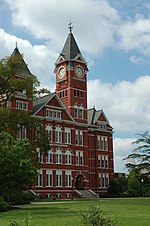Old Rotation | |
 The Old Rotation at Auburn University | |
| Location | Auburn University, Auburn, Alabama |
|---|---|
| Coordinates | 32°35′36″N 85°29′9″W / 32.59333°N 85.48583°W |
| Built | 1896 |
| NRHP reference No. | 87002390 [1] |
| Added to NRHP | January 14, 1988 |
The Old Rotation is a soil fertility experiment on the Auburn University campus in Auburn, Alabama. The Old Rotation experiment, which started in 1896, is the third-oldest ongoing field crop experiment in the United States and the oldest continuous cotton experiment in the world. It was the first experiment to show that a cotton/ legume crop rotation would allow soil to support a cotton crop indefinitely. The Old Rotation is listed on the National Register of Historic Places.
History
For much of the latter part of the 19th century, cotton yields in the Southern United States suffered declines caused by planting the same crop on the same land year after year, a process which caused significant soil nutrient loss. In 1896, Professor J. F. Duggar of the Alabama Agricultural and Mechanical College set up the Old Rotation experiment on a one-acre (1,600 m²) plot of land one mile (1.6 km) south of the campus to test whether soil nutrient levels could be maintained by growing a crop of legumes on the same land as cotton, but in the winter months when cotton doesn't grow. This rotation of cotton and soybeans has continued uninterrupted since. In addition to the cotton/legume rotation, additional rotations have been added in adjacent plots consisting of a cotton/corn, cotton/corn/legume and cotton/corn/legume/soybean rotation. It became evident within a few years that adding the winter legume crop as a rotation was sufficient to restore adequate nutrients to the soil to maintain a yearly cotton crop indefinitely. [2]
Experiment
The Old Rotation consists of 13 plots of six planting systems:
- A control test where cotton is planted without rotation or fertilizer
- Cotton rotated with winter legumes but not fertilized
- Cotton just fertilized
- Cotton rotated with corn and winter legumes
- Cotton rotated with corn, winter legumes, and fertilizer
- Cotton rotated with corn, winter legumes, and soybeans [3]
After 110 years of continuous plantings, cotton yields remain high for the rotated plots, producing nearly three times the yield of the unrotated plots.
Miscellaneous
The Old Rotation is located adjacent to the Donald E. Davis Arboretum on Lem Morrison Drive in Auburn. The Rotation was placed on the National Register of Historic Places on February 14, 1988.
Photo gallery
See also
- Long-term experiment
- Cullars Rotation - A similar nearby agricultural rotation experiment.
- National Register of Historic Places listings in Lee County, Alabama
References
- ^ "National Register Information System". National Register of Historic Places. National Park Service. April 15, 2008.
- ^ Kay, Steven M.; Charles C. Mitchell, Jr. (June 1, 1987). "The Old Rotation". National Register of Historic Places Inventory-Nomination Form. National Park Service. Archived (PDF) from the original on March 11, 2014. Retrieved March 11, 2014. See also: "Accompanying photos". Archived (PDF) from the original on March 11, 2014. Retrieved March 11, 2014.
- ^ "Old Rotation". Auburn University Department of Agronomy and Soils. February 2004. Retrieved March 11, 2014.
- Elstein, David (2003). ARS improves yields in 100-year-old experiment; the 106th cotton crop grown on the Old Rotation—the world's oldest cotton experiment. Agricultural Research, May 2003.
- Logue, Mickey & Simms, Jack (1996). Auburn: A Pictorial History of the Loveliest Village, Revised. Auburn, Ala. ISBN 1-885860-08-0








